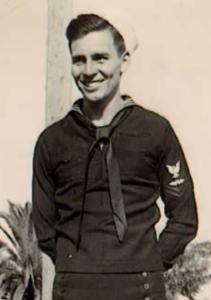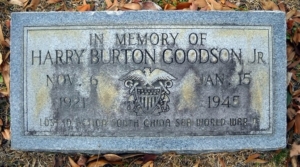Scroll of Honor – Harry Burton Goodson, Jr.
Kamikazi Victim
Written by: Kelly Durham
Relatively few enrolled in college during the 1930s. Of those who did, fewer still graduated. The academics were rigorous and the economic status of many families prohibited the luxury of a college education.
economic status of many families prohibited the luxury of a college education.
Nonetheless, Harry Burton Goodson, Jr. of Florence matriculated at Clemson College as a member of the Class of 1943. Goodson, an agriculture major, remained in school only his freshman year, 1939-40, before taking employment with the Atlantic Coast Line Railroad. In December 1941, Goodson volunteered for the Navy.
World War II, as dramatically demonstrated at Pearl Harbor, ushered in the age of the aircraft carrier as any Navy’s primary offensive weapon. The United States Navy included a handful of carriers at the outset of hostilities, but by the end of the war, one hundred forty-three carriers had been built in American shipyards. Famous fleet carriers, like Yorktown now a memorial in Charleston Harbor, carried the fight in the Pacific ever closer to the Japanese home islands. Naval architects soon designed smaller escort carriers to handle varied other missions. These smaller, lightly-armored carriers provided air cover for transoceanic convoys and served as ferries to move aircraft from the United States into combat theaters. As the war progressed, escort carriers helped provide combat air patrol for the massive Allied fleets operating in the Pacific. The most numerous class of escort carriers was the Casablanca class, which included CVE-61, the USS Manila Bay.
Among this ship’s crew was Harry Goodson, an aviation metalsmith. By the beginning of 1945, Goodson was already a veteran of two  years of Pacific duty, years that had seen the fortunes of war turn in favor of the United States. America’s ability to mass produce airplanes and ships, like the Manila Bay, was one of the key factors in this turn of events. The airplanes launching daily from the Pacific Fleet’s carriers required extensive maintenance in order to keep them flying in the demanding environment of combat at sea. Goodson’s job was to maintain and repair aircraft, airframes, and components.
years of Pacific duty, years that had seen the fortunes of war turn in favor of the United States. America’s ability to mass produce airplanes and ships, like the Manila Bay, was one of the key factors in this turn of events. The airplanes launching daily from the Pacific Fleet’s carriers required extensive maintenance in order to keep them flying in the demanding environment of combat at sea. Goodson’s job was to maintain and repair aircraft, airframes, and components.
On New Year’s Day 1945, Manila Bay left Manu, north of New Guinea, and sailed north for the Philippines as part of Vice Admiral Jesse Oldendorf’s Bombardment and Fire Support Group. Japanese air forces had grown continually weaker as the Allies, led by the United States, committed ever increasing resources to the battle. But in October, during the initial stages of General MacArthur’s invasion of the Philippines, the Japanese had initiated organized suicide attacks. These attackers, which became known as kamikazes, generated controversy among Japanese military leaders, according to Pacific War historian Ian Toll. Many Japanese argued that such tactics misconstrued traditional samurai ideals. Nonetheless, by late 1944, kamikaze attacks were increasingly employed as Japanese military and naval strength diminished under the relentless Allied onslaught.
Japanese attacks against Oldendorf’s task group commenced on January 4 in the vicinity of the Mindoro Strait. Carriers were primary targets for kamikaze pilots. American airpower was decimating Japan’s war making capability and carriers were, with their distinctive flight decks, easy targets to identify from the air. Despite combat air patrols protecting the fleet from above, a kamikaze crashed into the flight deck of USS Ommaney Bay, an escort carrier similar to Manila Bay, causing her to sink.

January 5, 1945. Image of Manila Bay, taken just moments after she was crashed by a kamikaze at the base of her island. Official U.S. Navy photograph
Enemy air attacks intensified on January 5, with repeated waves of attackers sweeping in during the morning and afternoon. Just before 1750 hours, two kamikazes dove on Manila Bay. The first plane plunged into the ship just behind the bridge, igniting fires on the flight deck and just below on the hangar deck where airplanes were maintained and repaired between operations. The second plane, mercifully, missed, crashing into the sea just off the starboard fantail. Firefighting parties quickly brought the blaze under control, but fourteen men had been killed, including Harry Goodson.
Goodson was survived by his wife Belva and their son Harry B. Goodson, III. He was also survived by his father and sister. Although no remains were recovered, Goodson is memorialized on the Manila American Military Cemetery’s Tablets of the Missing and on a marker in Florence’s Mount Hope Cemetery.
For additional information about Harry B. Goodson, Jr. see:
https://soh.alumni.clemson.edu/scroll/harry-burton-goodson-jr/
For more information about Clemson University’s Scroll of Honor visit:
https://soh.alumni.clemson.edu/
